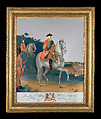Equestrian portrait of William, Duke of Cumberland (1721–1765)
after a portrait by David Morier
and an engraving by Louis Simon Lempereur French
This arresting equestrian portrait of William, Duke of Cumberland (1721–65) tells a fascinating story about Anglo-Scottish and continental European politics in the 1740s and 50s, as well as about the luxury trade between Europe and China during the second half of the Qianlong Emperor’s long reign. It is the product of a Cantonese workshop from around 1751–60 and a tangible document recording a moment when European trade with mainland China was conducted through the British and the Swedish East India Companies exclusively via the port of Canton (now Guangzhou).
The sitter, William, Duke of Cumberland, a soldier prince nicknamed “Sweet William” by his admirers and “Butcher Cumberland” by his enemies, was the favorite son of George II, King of the United Kingdom and Elector of Hanover, and his consort, Caroline of Ansbach. He is best remembered for putting an end to the Jacobite Rebellion by defeating the troops of his distant cousin, the Stuart pretender “Bonnie Prince Charlie” at the Battle of Culloden, near Inverness in 1746. Cumberland thus secured the Hanoverian rule, which the Stuarts had been challenging for more than 30 years.
The refinement of the duke’s portrait contrasts with the relative brutality of the man it depicts. The portrait must derive from one of the particularly successful workshops producing reverse-painter mirrors in Canton. The composition goes back to a 1751 print produced by the French artist Louis Simon Lempereur (1728–1807), engraved during his sojourn in London; it, in turn, copies an oil composition by the Swiss-born David Morier (1705–1770), who specialized in portraits, military and sporting pictures.
The portrait shows Cumberland mounted on a charger, donning a black tricorn hat and a scarlet uniform with the blue ribband (sash) of the Order of the Garter bestowed on him in 1730; the landscape in the background opens the view to a battle with regiments in formation. The duke is attended by a senior officer on horseback and, as a repoussoir figure seen from behind, a Pandour soldier of the Habsburg “Freikorps Trenck” holding a rifle. The Freikorps (free corps) was a light infantry unit of ca. 1000 irregulars under the leadership of Baron Franz von der Trenck (1711–49). The presence of a Pandour soldier in Morier’s composition and its copies, implies that the portrait shows Cumberland on one of his continental campaigns during the Austrian War of Succession (1740–48). Most likely it represents the successful Battle of Dettingen (21 June 1743), remembered today as the last instant when a British monarch, George II accompanied by Cumberland, personally lead his troops into battle.
This image cannot be enlarged, viewed at full screen, or downloaded.

